New York, New York- a city that doesn’t sleep, as Frank Sinatra calls it. The opportunities of what to do are far from few, many of which you might not have known existed! New York has many cultural Jewish gems– some obvious, some tasty, and some hidden to only the most observant and curious. Go: explore and discover the city of immigrants, food, and history. We promise you won’t be disappointed.
Lower East Side Conservancy
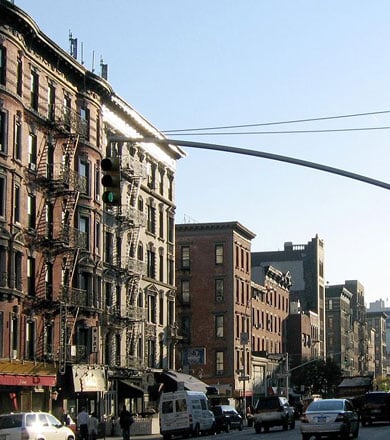
New York’s Lower East Side was once the place to be for new arrivals to America, being both its most famous immigrant neighborhood and the birthplace of the American-Jewish community. It’s a living, breathing historical and cultural Jewish gem, and still boasts an active community today.
The Lower East Side Jewish Conservancy is an organization which preserves, shares, and celebrates this heritage across the 32-blocks, designated as a historic district. You’ll be hard pressed not to find what you’re looking for- there are numerous synagogues, restaurants, and museums to keep everyone happy and interested.
Hebrew Free Burial Association
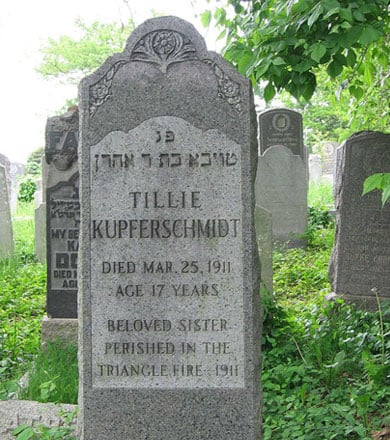
What do Mel Brooks’ grandparents and Jewish inmates of Rikers Island have in common? Both have been buried by the Hebrew Free Burial Association (HFBA).
As its name suggests, the HFBA bury Jewish New Yorkers for free; it’s the largest free burial society outside of Israel. The organization is cross-denominational, working to ensure that recently deceased Jews of all persuasions are given a full Jewish burial, in line with Jewish law. The HFBA is a reflection of modern 20th-century history, burying mainly locals from the immigrant and current community. They’ve also buried Jewish victims of World War II, and the Spanish American War, shipping bodies back from as far away as Manila and New Guinea.
Tenement Museum
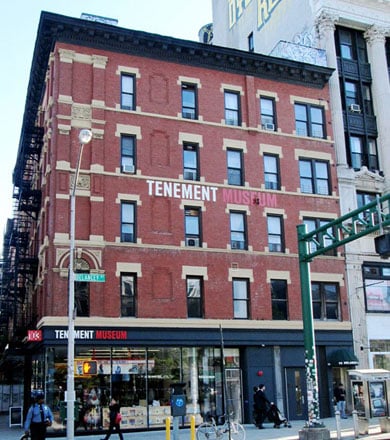
While not strictly a ‘hidden’ gem, the Tenement Museum is still a fascinating insight into Jewish new Yorker lifestyles. The action takes place on the Lower East Side (you’re beginning to see a theme here, right?), or 97 Orchard Street, to be precise, which was home to a mind-boggling 7000 working class immigrants.
Visitors can go on a guided tour around the building and around the neighborhood, recreating 19th-20th-century immigrant life. There are also a range of other activities, known as ‘Tenement Talks’: free readings, discussions, performances, and screenings about New York‘s history, population, and culture.
Congregation Ohab Zeded
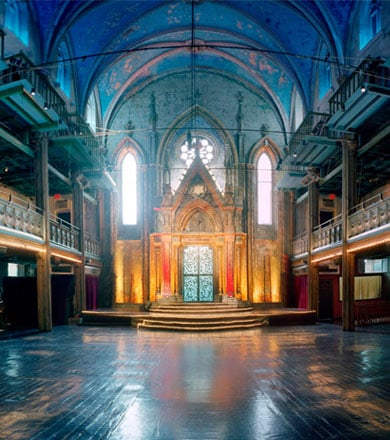
Known formally as ‘The First Hungarian Congregation Ohab Zedek’, the synagogue has, like most of its congregants, schlepped to various places across the city: established on the Lower East Side, before moving to Norfolk Street, then Harlem, it has settled (and stayed put) at its current location (118 West 95th Street). Harking back to other areas of Jewish history (and entry of our blog!) it is built in a striking Spanish-Moorish style. On an important side-note, it’s also well-known for attracting large numbers of Orthodox Jewish singles. They say Orthodox Jewish dating in New York is tricky, alas here’s the solution!
Yonah Schimmel Knish Bakery
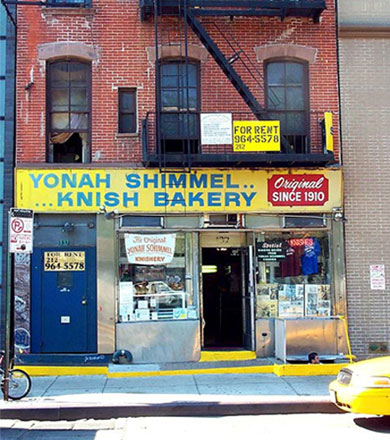
It would be impossible to use ‘Jews’ and ‘New York’ in one breath without coming to the obvious common denominator– food! With the slogan, ‘One world. One taste. One knish. That’s it!’ and the claim to produce ‘The World’s Finest Knishes’, Yonah Schimmel’s knishes are something that you just have to try for yourself.
He has perfected his knishes since opening in 1910. What are knishes you ask? They’re a fried roll of dough, stuffed with various fillings – such as meat, kasha, or potato. We recommend you discover them for yourself.
Congregation Shearith Israel
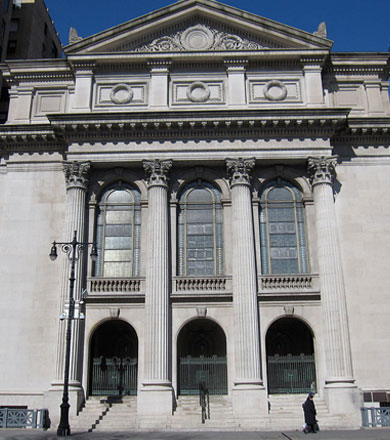
Although we usually associate Jewish New York with typically Ashkenazi things, such as bagels and Woody Allen, it turns out that the first Jews in New York were actually Sephardim (yes, we are being serious)!
Congregation Shearith Israel (also known as ‘The Spanish and Portuguese Synagogue’) is the oldest in the US, dating back to 1654. Like the Sephardim, the congregation was forced to migrate around New York, before finally settling in its present-day West 70th Street location. It’s also the official birthplace of the Orthodox Union (and the infamous OU logo). For its history and some of its famous members (including three gunsa macher Judges), this synagogue begs a visit.
Triangle Fire
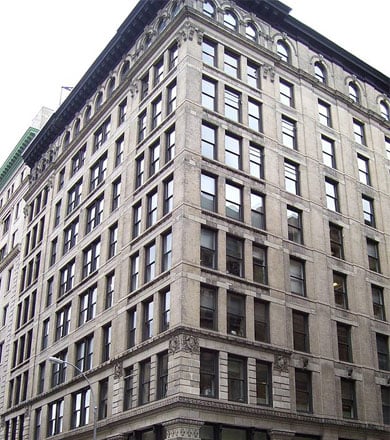
The deadliest disaster to strike New York until the 9/11 attacks 90 years later, the Triangle Shirtwaist Factory disaster is important for many reasons. The Brown Building stands as a monument to the 146 Jewish and Italian immigrants killed by a massive fire and locked doors, and is both a National Historic Landmark and a New York City Landmark. Most of the Jewish victims were buried in the Hebrew Free Burial Cemetery (another entry on our list) with tombstones referring to the fire. For a modern memorial, time your visit with ‘Chalk’, an annual project by local New York filmmaker Ruth Sergel, where local artists walk across the city, chalking the names and ages of the victims onto their former homes.
Guss’ Pickles
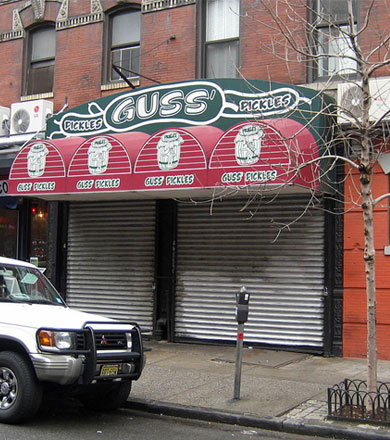
Much like his pickles, Guss’ backstory makes for a vibrant, and enticing read. Izzy Guss arrived from Europe over 100 years ago, selling pickles ‘old country’ style from his, now legendary, pickle stand in the Lower East Side. His pickles have become a symbol of New York itself according to the official slogan, ‘Imitated but never duplicated’.
They’re one of a kind, and are indeed world famous – they’re now even available in supermarkets. For the real deal and to sample delights such as the Guss Sour, Guss Sour Tomato, or even the Guss Sauerkraut, visit the original site, for a pickle ‘prepared with love like in the good old days’.
Spanish Portuguese Cemeteries
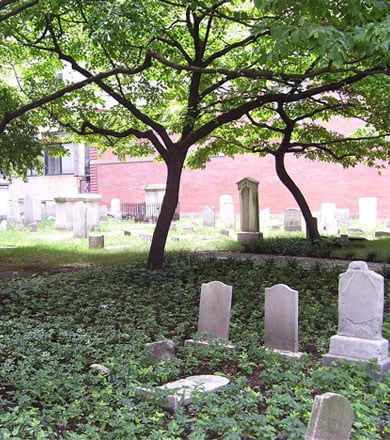
Three hidden away Jewish cemeteries, one tucked behind a block of condos in the middle of Manhattan; the other two further downtown, are the legacy of North America’s oldest Jewish congregation, Shearith Israel (also featured on our list).
The first, in Chinatown, is the oldest Jewish cemetery in North America and hosts the final resting places of 22 American Revolution veterans and the first American-born rabbi. The second, amongst Greenwich Village townhouses, still has twenty headstones standing. The third cemetery is just off 21st and 6th Avenue, with 250 graves (some still legible), and is perhaps the most picturesque and evocative of a bygone era.
Emma Lazarus plaque, Battery Park
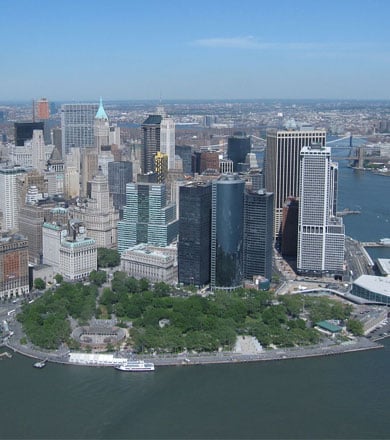
Battery Park is synonymous with New York’s immigrant past, but did you know that this impression is largely due to a plaque inscribed on Lady Liberty? Emma Lazarus, a famous American-Jewish
poet, wrote her 1883 sonnet ‘The New Colossus’, to celebrate America as the land of freedom and destination for the ‘huddled masses yearning to be free’– amongst them, her fellow Jews. Part of the poem is inscribed and mounted onto the Statue of Liberty, dedicated in 1955 to New York City. As if that wasn’t Jewish enough, the plaque itself is set in a stone gifted from the State of Israel to the Sisterhood of the Spanish and Portuguese synagogues (another entry on our list).

